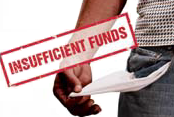Does this sound familiar? You go home after a long day of work only to be bombarded by overdraft protection notices in the mail indicating that you need to “opt-in” or out of the program by August 15th. That’s convenient. The last thing you want to do is read some financial agreement in fine print with confusing terms. Depending on your state of mind at the time, you may even accept the banks offer since the marketing language in the agreement may make it seem as though it is the right thing to do. With that said, let’s put the overdraft protection program in more digestive terms so we can all understand exactly what opting-in means.
 How Overdraft Protection Works
How Overdraft Protection Works
In the past, almost all banks would automatically enroll customers into a overdraft protection program. In simple terms, this means the protection allows you to draw on your bank account with a debit card or ATM withdrawal even if you have insufficient funds. The downside is that you will be charged an initial fee of $20 to $35 depending on your bank. Now, recent financial reform is mandating all banks to request that existing debit card account holders CONSENT to the overdraft protection program. If the account holders do not consent, then their debt card transaction or ATM withdrawal will be rejected & thus no fee will be charged. The reform doesn’t apply to automatic charges for overdrawn checks, pre-authorized electronic payments, & recurring debit card transactions.
Overdraft Protection is Very Profitable For the Banks
There is a reason why the banks are crowding your ATM screen, flooding your mailbox & even having the bank tellers remind you about the overdraft protection program. It is very profitable for banks, gross revenues for overdraft fees were ~$37.1B in 2009, almost double the amount in 2000 (Moeb Research). The other point to keep in mind is that the larger banks charge initial overdraft fees of $35 yet the average purchase using a debt card is usual less than $20 (Center For Responsible Lending). Nice spread for the banks.
How Much Can it Cost?
The initial fees are $20 to $35. However, if you fail to deposit money to bring your account balance back to a positive amount within a few days after the overdraft you can be charged sustainable fees. As an example, if you withdrew $40 at your PNC Bank ATM but only had$10 available, you would immediately be charged a $25 overdraft fee & then an additional $7 a day starting on the 4th day the account is still overdrawn. The total fee in just 10 days would be as high as $67 for a PNC Bank account holder.
No Overdraft Protection
Next time you are prompted with an overdraft protection offer via an ATM, bank teller, or snail mail, simply reject it. Rather, focus on budgeting better to avoid being in a position in which you don’t have enough funds to complete a transaction.
More Personal Finance Questions?
If so, our Finance Experts are happy to help answer all of your finance questions.
Related Articles
->Protecting Your Bank Account
->Buying A Lottery Ticket Is Like Lighting Money on Fire…Maybe Not
->Negotiating Salary With Companies Focused on the Recession
->Marrying Someone that Just Filed For Bankruptcy?


